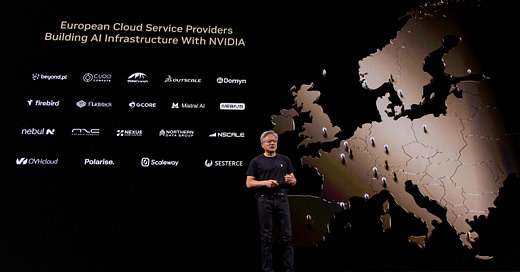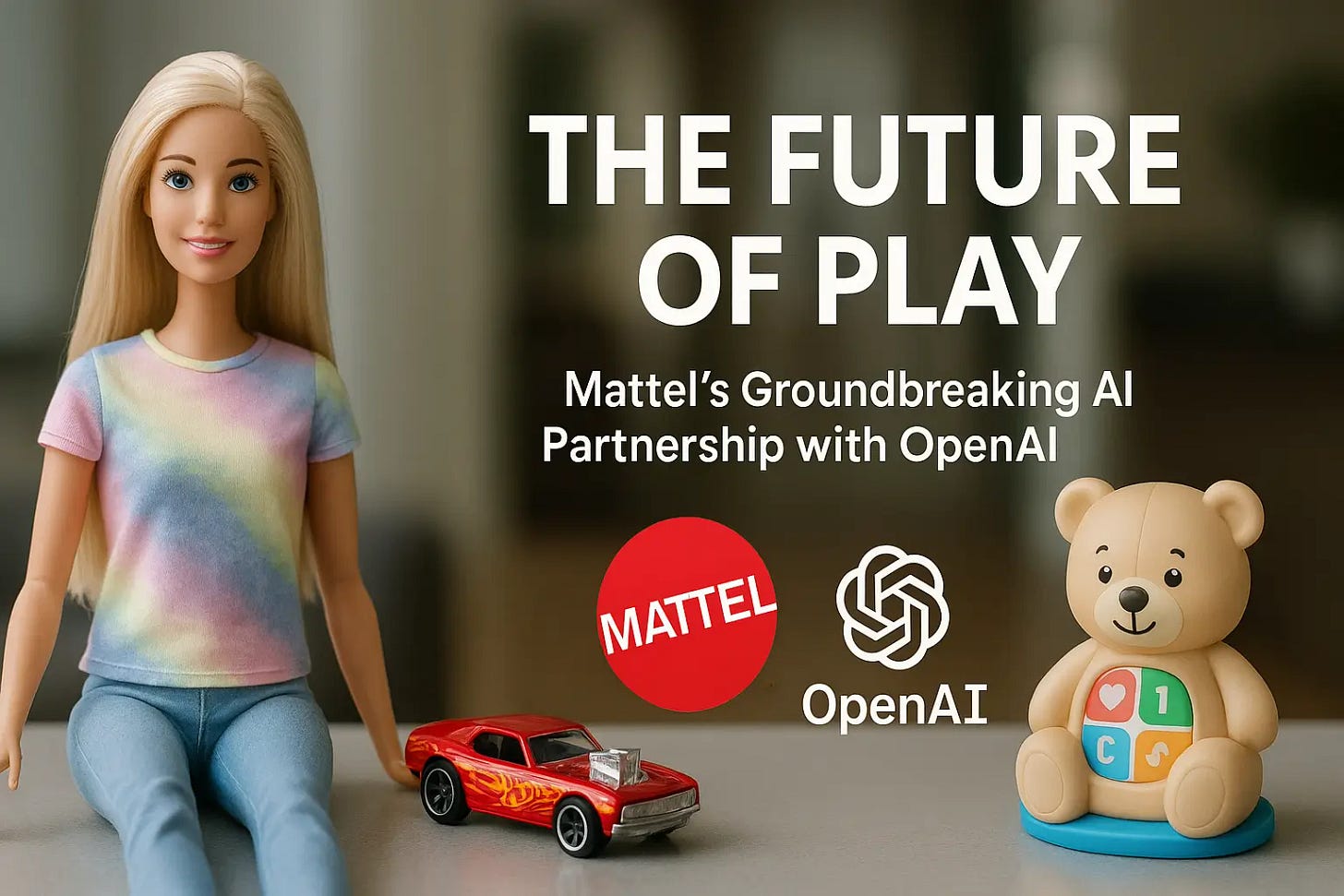GTC Paris: Sovereign AI
A new era where AI infrastructure is as central to sovereignty and economic security as energy grids or defense systems.
Good morning AI entrepreneurs & enthusiasts,
NVIDIA’s GTC Paris wasn’t just another tech conference—it was a strategic turning point in how nations approach AI. Jensen Huang framed a new era, where AI infrastructure is as central to sovereignty and economic security as energy grids or defense systems.
The unveiling of Grace Blackwell felt less like a hardware launch and more like a geopolitical chess move. Europe is investing in its own backbone. And the message from Paris was unmistakable: in the race to define AI’s future, Europe plans to write its own rules.
In today’s AI news:
Biggest Recaps of NVIDIA GTC Paris 2025
Open Molecules 2025
OpenAI & Mattel to Launch AI Toys
Today's Top Tools & Quick News
Biggest Recaps of NVIDIA GTC Paris 2025
The News: NVIDIA’s GTC Paris 2025 showcased Europe’s growing AI leadership with major hardware announcements, sovereign infrastructure initiatives, and strategic partnerships that cemented the continent’s role in global AI development.
The details:
CEO Jensen Huang emphasized Europe’s commitment to building its own "AI industry" and "intelligence infrastructure," collaborating with governments and enterprises to build sovereign AI factories.
Europe’s AI compute capacity is expected to grow 10x over the next two years, thanks to partners producing 1,000 Grace Blackwell 200 systems every week.
The Grace Blackwell NVL72 system—described as "one giant GPU"—blurs the line between cloud and supercomputer, unlocking new capabilities for real-time reasoning, simulation, and quantum-hybrid workflows.
Physical AI is emerging as the next wave, with Isaac, Omniverse, and Halos enabling robots that learn, adapt, and move based on simple prompts—like ChatGPT, but embodied.
Autonomous vehicle platforms saw major upgrades too, with new world-scale foundation models and simulation tools reshaping how AVs are trained and validated.
Even amid China export bans and global chip supply pressure, NVIDIA signaled confidence in its roadmap—betting on Europe’s hunger to build AI infrastructure at the edge, not just in the cloud.
Why it matters: GTC Paris felt less like a launch event and more like an inflection point. NVIDIA isn’t just selling hardware—it’s embedding itself into the foundation of Europe's digital future. What we’re witnessing is AI infrastructure as economic strategy, and NVIDIA is helping draw the blueprint.
Open Molecules 2025
The News: Meta, Los Alamos National Laboratory, and Lawrence Berkeley National Laboratory have released Open Molecules 2025 (OMol25), a massive open-source dataset of over 100 million high-accuracy quantum chemistry simulations.
The details:
OMol25 spans 83 elements and includes 3D molecular structures with up to 350 atoms each, covering a range of small molecules, biomolecules, metal complexes, and electrolytes.
Each molecule includes DFT-level properties, computed using omegaB97M-V/def2-TZVPD theory, totaling ~6 billion compute core hours.
The dataset aims to accelerate the development of machine-learned interatomic potentials (MLIPs) for use in AI-driven drug discovery, energy storage, and materials science.
Meta also introduced the Universal Model for Atoms (UMA), a DFT-accurate ML model trained on OMol25, enabling 10,000x speedups in molecular simulation.
Why it matters: OMol25 represents a major leap for AI and chemistry alike, combining unprecedented molecular diversity, scale, and accuracy in a single open-source dataset. It opens the door for researchers to build AI models that predict molecular behavior with near-quantum precision—fast enough to run thousands of simulations in minutes. That kind of accessibility could accelerate discoveries in medicine, energy, and materials science at a pace we’ve never seen before.
OpenAI & Mattel to Launch AI Toys
The News: OpenAI and Mattel announced a major partnership to bring generative AI to Mattel’s flagship brands—including Barbie, Hot Wheels, and American Girl—creating intelligent physical toys and immersive digital experiences. The first wave is expected by the end of 2025.
The details:
AI will be integrated into iconic franchises through interactive toys, digital assistants, and companion apps. Early examples include smart versions of UNO and Magic 8 Ball, and even character-based digital assistants.
Mattel teams will use ChatGPT Enterprise across the organization—from creative brainstorming to engineering—streamlining product development and infusing AI into the ideation process.
The first rollout is slated for late 2025, with long-term AI integrations expected across Mattel’s brand portfolio.
Why it matters: This is a landmark moment for the toy industry. AI-powered toys could personalize play to match developmental stages, creating experiences that evolve with a child’s curiosity. But it also raises questions: What happens when AI influences behavior from a young age? Can brands balance innovation with child-safe design and privacy? This partnership is poised to redefine play—and test how ready society is to merge AI with childhood.
What do you think of this news? Is this the next natural progression for consumer toys or an invasion of privacy for children?
Today’s Top Tools
Dia - The Browser Company’s new AI-first web browser
Meta AI - New video editing capabilities for short-form content
Windsurf Browser - Integrated with coding assistant for in-context support
Manus Chat Mode - Free, unlimited AI chat with instant answers
Quick News
Bytedance's Seaweed APT2: Streams real-time, 24 fps videos up to five minutes long for next-gen interactive content using a hybrid-flow transformer and 64x VAE compression.
Microsoft Copilot Vision: Enables screen-aware assistance that delivers contextual guidance based on user activity and live screen annotations.
Google DeepMind’s Weather Lab: An interactive AI-powered forecasting tool offering early and accurate storm predictions through collaboration with hurricane centers.
Apple’s AI Siri Overhaul: Spring 2026 release planned for Siri’s generative AI upgrade via iOS 26.4, following delays from its original WWDC 2024 announcement.
Runway Chat Mode: A conversational interface that lets users generate and edit visuals using natural language, already being tested for storytelling by Lionsgate and Tribeca.
AMD Instinct MI400: New GPU chips revealed with Sam Altman, offering a low-cost, high-performance alternative to Nvidia with 432GB HBM4 and 30% lower power usage.
Thanks for reading this far! Stay ahead of the curve with my daily AI newsletter—bringing you the latest in AI news, innovation, and leadership every single day, 365 days a year. See you tomorrow for more!




I couldn't get audio on the Jensen video, in either Safari or Chrome on my Mac - or in the Substack app on my iPad.
Video on YouTube.com played audio just fine.
Sovereign AI might be the new tariff. Exciting for local trust signals, but what does it do to shared training data that fuels today’s omnichannel campaigns?